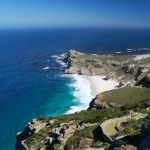Cape of Good Hope, SA
The Cape of Good Hope is located in the very south of the African continent, on the Cape Peninsula in South Africa. It is often mistakenly called the southernmost point of Africa. Actually, the southernmost tip is the Cape of Needles (Agulhas), while the Cape of Good Hope is the farthest south-western point.
The very first name of this hostile to seamen place was the Cape of Tempests – Cabo Tormentoso. Such was the name given to it by Portuguese Bartolomeu Dias in 1487 when his ship reached the cape during harsh storms. Seamen were looking for a way to India, but the Cape of Tempests did not meet their expectations and soon they had to turn back.
But later Portuguese king John II renamed the cape into the Cape of Good Hope — this route to India at last turned out to be the right one. The first European who got to the Indian Ocean after passing by this cape was Vasco da Gamma in 1497.
The Cape of Good Hope despite its optimistic name has always been in bad repute with sailors.
Strong winds were always blowing here often causing storms; strong currents would drift the ships on to the rocks; all the mountains on the shore were as alike as two peas making it altogether impossible to get oriented. Seamen, on their way from India would often err in their calculations and make their turns too early getting instead of the Atlantic Ocean into the False Bay and crashing into the shore. Sometimes these voyages ended tragically for them.
But the idea to build a lighthouse on this spot was shaped only in 1853, when representatives of local authorities inspected the shoreline and suddenly saw icebergs in the sea – a sight, which is not quite uncommon in the vicinities of the Cape.
So said so done – and the lighthouse was built. But the lighthouse on top of the cape at the height of 271 meters is not functioning. It was commissioned, as they say nowadays, in May of 1860, but – alas! – it did not benefit sailors at all, because due to the clouds fully covering the peak of the cape at dusk and at nights the light of the most powerful in those times lighthouse in the world was absolutely useless to seamen.
How many ships sank because of such an approach is not known for sure, the lighthouse was dutifully serving for over fifty years since the authorities were strongly unwilling to confess that engineers were wrong. Even after a brand new steamer “Kakapu” made such a bad mistake in its course that it ended up on the beach wholly ashore all the blame was laid upon a drunken captain. Who knows, maybe the captain was not sober indeed but it would not make the lighthouse more operational.
The decision was ripe only in 1911, when Portuguese liner “Lusitania” struck a riff. Only because of the lighthouse keeper’s actions, who ran out to the shore with a lantern practically all the passengers of the liner could be saved – boats with survivors barely missed the invisible rocky ridges in darkness.
Only after that incident the authorities determined to build a new lighthouse – at the height of only 88 meters, which can be seen from only 40 kilometers. But this one is visible.
Anyhow, the old lighthouse is still very popular and most of the visitors know nothing about its idle status. Several shops, a restaurant and a cable car “The Flying Dutchman” are built at the lighthouse.
Why “The Flying Dutchman?” It is because this was the place where the mysterious ship was seen most frequently, the captain of which in 1860 sold his soul to the devil for a chance to get out of a storm. This ship more often than not was seen by those who were doomed to ill fortune soon after.
In 1881, this opportunity was happily slept away by the future king of Great Britain George V, while all the rest of the crew of his boat saw the wretched ship. The history, though, keeps it untold whether anything terrible happened later to the unlucky sailors.
Up to now stories are told about the frequent cases of the ghost ship appearing on the horizon. According to witnesses’ testimonies, it looks like a life-battered and weather-worn sailing ship, which dissolves in the air as it nears the shore. The last documented testimony about the “Flying Dutchman” appeared in the German submarine’s log book in 1942.
There is not only the lighthouse on the Cape of Good Hope. Wild nature reserve of the same name is located there too. It is a home for several thousand plants – mainly, low thick bushes. In the reserve many rare animals dwell – antelopes, ostriches, zebras, baboons. You can go fishing here and many people enjoy amateur angling from boats. The local fish snook is especially popular, for it casts off all its scales when it is caught. Almost one meter long, weighing 4-5 kilograms, this fish is already scaled!
And the most interesting animals are penguins. Penguins got to Africa from Antarctica and they liked the place – it is warm and rich with food. In some time the birds found out that besides the coastline there is another and more interesting thing here – human settlements. Penguins rushed into the homes of local dwellers and soon turned into a real disaster. With great efforts people edged them out into a special zone on a beach where the birds have been living ever after.

